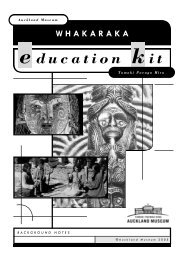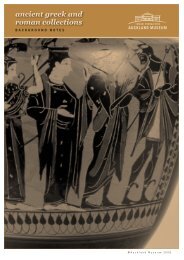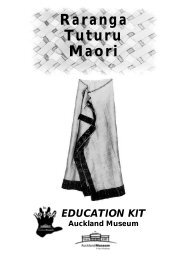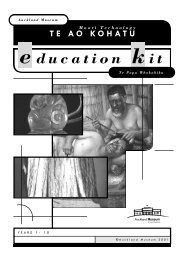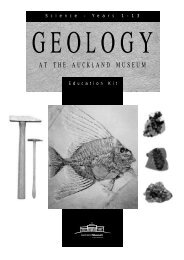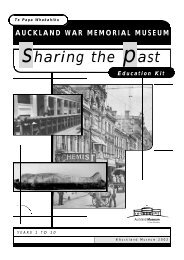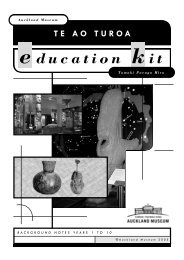Tukutuku Tuturu Maori - Auckland Museum
Tukutuku Tuturu Maori - Auckland Museum
Tukutuku Tuturu Maori - Auckland Museum
You also want an ePaper? Increase the reach of your titles
YUMPU automatically turns print PDFs into web optimized ePapers that Google loves.
Assessment<br />
The teacher notes the extent to<br />
w hich the students understand<br />
the meanings of the <strong>Tukutuku</strong><br />
patterns they have explored in<br />
the course of the study.<br />
Visual language: Presenting<br />
Using static… images, students<br />
should:<br />
• present ideas using simple<br />
<strong>Tukutuku</strong> designs<br />
• use verbal and visual features<br />
to communicate ideas or<br />
stories using <strong>Tukutuku</strong><br />
patterns.<br />
Teaching and Learning<br />
Context: exploring the<br />
interrelationship between<br />
dramatic, verbal, and visual<br />
features<br />
• The teacher and students<br />
collaborate in writing a story<br />
from a shared ex perience.<br />
• The teacher and students<br />
select t he main features of<br />
their story that can be<br />
portrayed in s imple tukutuku<br />
design.<br />
• Individually or in small<br />
groups, students choose one<br />
of the main features, and<br />
using peg-board and raffia,<br />
create a tukutuku design to<br />
reflect their choice.<br />
• Captio ns are written for eac h<br />
design.<br />
• Students arrange t heir work<br />
in sequence to build a class<br />
storyboard display.<br />
• The teacher and students<br />
discuss how the story<br />
sequence is illustrated in<br />
tukutuku patterns.<br />
Assessment<br />
• The teacher assesses the<br />
students' ability to retell t he<br />
story and choose suitable<br />
images.<br />
• The teacher observes the<br />
students during t he activit y<br />
and notes their participation,<br />
awareness, and<br />
understanding of how words<br />
and images relate to one<br />
another.<br />
© 1997 <strong>Auckland</strong> <strong>Museum</strong><br />
Levels 1 - 2<br />
Visual Language: Presenting<br />
Using static images…students<br />
should:<br />
• use verbal and visual features<br />
to communicate information,<br />
ideas or narrative t hrough<br />
tukutuku pattern<br />
• combine verbal and visual<br />
features to communicate<br />
information, ideas or<br />
narrative through tukutuku<br />
pattern`<br />
Teaching and Learning<br />
Context: a topic related to the<br />
locality<br />
• Students ex amine a range of<br />
tukutuku patterns, and note<br />
features of language and<br />
presentation, such as layout<br />
and design.<br />
• Each group of students is set<br />
the task of producing a group<br />
design to promote some<br />
significant feature of their<br />
locality to visitors.<br />
• Students gather, collate, and<br />
assemble the necessary<br />
information ready for<br />
developing their presentation.<br />
• The groups prepare t heir<br />
draft designs and discuss<br />
them with their peers for<br />
respo ns e in terms of<br />
suitability of the design and<br />
accuracy of informatio n.<br />
Draft patterns are revised.<br />
• Students create their designs<br />
and display them.<br />
Assessment<br />
• The teacher and students<br />
ex amine the designs and<br />
assess them for effectiveness,<br />
coherence of organisation,<br />
layout, and suitability for t he<br />
purpose.<br />
• The teacher observes<br />
students' participation in t he<br />
process and t heir<br />
understanding of the effects<br />
of visual language.<br />
Levels 3 - 4<br />
Visual Language: Viewing<br />
Reading visual… texts…<br />
12



